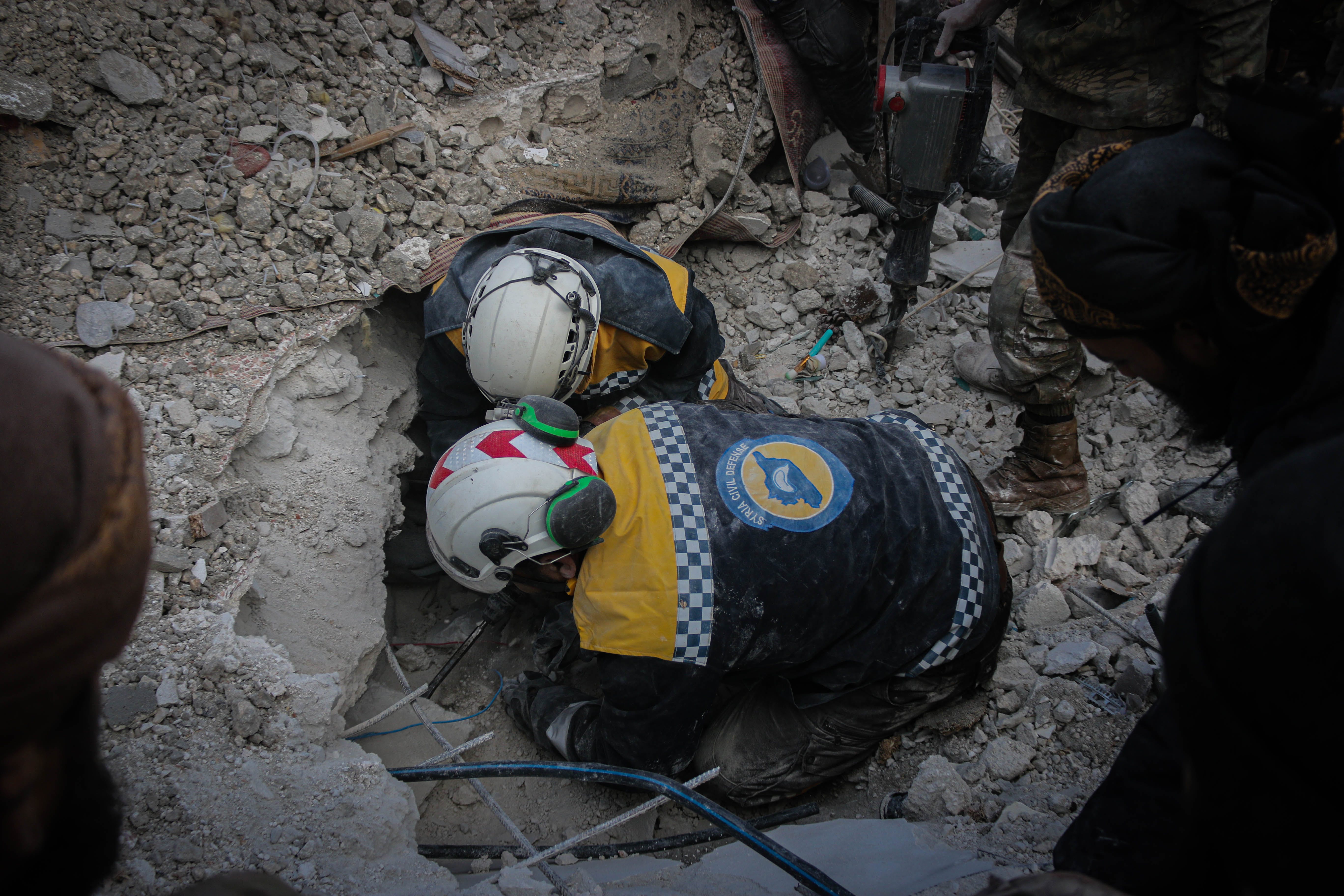Listen now on: Spotify | SoundCloud | Apple | YouTube
Protracted crises are situations of prolonged and sustained instability, conflict or humanitarian emergency that persist over an extended period of time.
The United Nations (UN) Secretary General wrote in his Protection of Civilians report to the UN Security Council this year, that the ‘average conflict duration is more than 30 years’.
How can the international humanitarian system maintain a response and support people impacted by crises that last for decades on end?
In this episode of I Think You’re On Mute, your host Beth Eggleston explores the nature of protracted crises, how humanitarian response differs compared to short-term emergencies, and what we can do to support local organisations and leadership with guests Jess Lees and Ahmad Shuja Jamal.
See podcast transcript below
Podcast host and guests
Beth Eggleston
Director, Humanitarian Advisory Group
Jess Lees
Director, Humanitarian Advisory Group
Jessica Lees (Jess) has been working in humanitarian response operations in Africa and the Asia-Pacific region over the past 10 years. Most recently, Jess has been coordinating Australia’s contribution to Red Cross aid operations in East African countries facing drought and famine. Jess has also deployed to Darfur, Sudan and coordinated aid in the aftermath of Typhoon Haiyan in the Philippines in 2013 and Cyclone Winston which ravaged Fiji in 2016. Since starting in the humanitarian sector Jess has worked for a range of humanitarian and development focussed non-governmental organisations, as well as the United Nations World Food Programme and most recently with Australian Red Cross. Jess holds a Bachelors degree in International Studies from RMIT University in Melbourne and a Master of International Crisis Management from Monash University.
Ahmad Shuja Jamal
Author, Academic & Advisor
Shuja served as the director-general for international relations and regional cooperation at the Afghan National Security Council, where he helped manage Afghanistan’s security partnerships. He also served as director for peace and civilian protection and handled Afghanistan’s policy portfolio on international sanctions.Prior to his civil service work, he was a researcher for Human Rights Watch and served as director for development at the American University of Afghanistan, helping to reopen the university after the devastating terrorist attack on campus in August 2016. Shuja currently serves as the head of policy, advocacy and communications at Jesuit Refugee Service Australia. He comes to this role after serving as a special advisor to the CEO of the Refugee Council of Australia.
Podcast research and links
- Humanitarian Horizons | Measuring Localisation: Framework and Tools
- Humanitarian Horizons | Field Handbook on the Protection of Civilians in Situations of Violence
- The Decline and Fall of Republican Afghanistan by Ahmad Shuja Jamal and William Maley
Podcast transcript
Beth Eggleston: Before we begin, I’d like to Acknowledge the Traditional Custodians and their ancestors of the unceded lands and waters on which we live, work and depend. We recognise all First Nations Peoples around the world and celebrate their enduring connections to Country, and pay our respects to Elders, past, present, and emerging.
Right now, across the globe, there are ongoing conflict crises. War in Ukraine, a record 6.9 million people displaced by conflict in Congo, and the dramatic escalation of conflict in Palestinian territories and Israel where international humanitarian law is being shattered.
It’s worth reiterating the words of Fabrizio Carboni, the regional director for the Near and Middle East of the International Committee of the Red Cross, “the human misery caused by this escalation is abhorrent, and I implore the sides to reduce the suffering of civilians.”
While these crises are in the news cycle for now, they are long term challenges. Not just one year, or five years, but decades long. In fact, the UN Secretary General wrote in his Protection of Civilians report to the UN Security Council this year, that the ‘average conflict duration is more than 30 years.’ So, what does this reality mean for the international humanitarian system that is meant to jump in quickly and save lives and alleviate suffering? How can such a system maintain a response, and the support for people impacted by protracted crises that last for decades on end? These are the questions we’ll be discussing in this episode of “I think You’re on Mute”, a podcast exploring who’s talking and who’s listening in a humanitarian emergency, and how we can improve humanitarian response for the better. I’m your host Beth Eggleston.
SOUNDBITE: We’re talking about Sudan, we’re talking about Syria, we’re talking about Afghanistan, Burkina Faso, Myanmar and Haiti. These crises are all different but in some ways they’re all the same. People suffer through no fault of their own, people don’t get the support that they need, solidarity internationally is expressed in limited form and sometimes without a clear objective and these are the issues we want to discuss when we discuss these crises. How can we perform better on behalf of you so that the people who are submerged in these places, affected by these crises, can have a chance to emerge and then again with their families to prosper.
Beth Eggleston: That was Martin Griffiths – Emergency Relief Coordinator (ERC) – he’s the top UN official who has the job of coordinating and advocating on behalf of the global humanitarian community. As each year passes, the number of people in dire need of assistance continues to rise. It’s becoming increasingly clear that the traditional humanitarian system can’t keep pace, so how do we support communities to emerge and prosper from ongoing, protracted crises?
I’d like to introduce my co-director at Humanitarian Advisory Group, Jess Lees. Jess has first-hand experience working in crisis situations. Jess, I’m really pleased we had a chat to you about protracted crises and I know it’s something we grapple a lot with at HAG and Australia’s new aid development policy has highlighted the number of disasters is escalating, with more than one every day by 2030, and many of these, as you know, will be taking place in already very fragile situations with high levels of debt, gender equality, weak governance, limited connectivity and high levels of poverty. And as I’ve just mentioned, you’ve worked in many of these crisis situations and so many of the places that you work still experience ongoing crises today. So in particular, Somalia, South Sudan and Mozambique, we’ve seen an uptick in violence in all of those contexts recently, and that’s combined with the severe climate induced impacts. Would you be able to unpack some of the complexity that perpetuates what we really call a protracted crisis?
Jess Lees: Thanks, Beth. So, as you said, I have worked in several protracted crisis conflicts over the years and I think the number one takeaway for me is that they are all so unique and so complex. Generally, what we see is a cycle of violence and tensions that are then exacerbated by other factors. So the violence has a cyclical nature because there are compounding factors. So it really makes it difficult for communities in these countries to be able to get out of the situations that they’re in because of the tensions that they’re facing that are then exacerbated by things like climate induced disasters, which then further escalate some of the tensions that are already there.
Beth Eggleston: Yeah, that’s exactly it – that cyclical nature. And Jess, when you were working in many of these contexts, you were working with UN agencies or international NGOs, what about some of the approaches that donor governments take when addressing protracted crises? Is it different to how they approach shorter term emergencies?
Jess Lees: Look, I think for donors, one of the main priority is trying to ensure that there are longer term funding windows than we might see in traditional rapid onset humanitarian crises. In a protracted crisis, there’s very little, little impact, little gains that you can make in a three-month or six-month funding window. So, it’s really about pursuing much longer term programs. So multi-year investments, number one. The other thing that’s really important is flexibility within those funding windows, because you do have these surges of violence and then that compounding natural disasters, you really need to be able to ensure that you can pivot the financing to be able to respond where there is the most immediate need. So things like crisis modifying they’re called, where there’s the ability for the organisations that are programming to say, well, actually we had these plans in place, our context is changed, can we quickly put in this modifier to be able to divert some of our activities, to be able to respond where the greatest need is? So long term financing and flexible financing are really key priorities for humanitarian, protracted crisis contexts.
Beth Eggleston: Well that makes a lot of sense because it goes to the challenge that you mentioned of the cyclical nature of these contexts, so that makes a lot of sense. And Jess, when it comes to the actual practicalities of delivering programs, I mean, what impact do you see in these protracted crises in terms of coordination, supporting locally led response, diversity and inclusion, protection – those key elements of humanitarian programming, how are they impacted by that ongoing nature of the crisis?
Jess Lees: I mean, I think it’s just really hard for humanitarian organisations to be able to sustain the level of operations that are needed in these contexts because they are so drawn out. So being able to resource in an ongoing capacity and ensure that all of those important mechanisms, the coordination forums and the like that you mentioned, are appropriately resourced and operational throughout these multi-year situations where you do have these ebbs and flows and upticks in violence is really, really difficult. Things like staff turnover in these crises for organisations at all levels is really problematic. It’s really difficult to recruit and sustain staff to be able to support the operations in an ongoing capacity, and that then further exacerbates some of the challenge for humanitarian actors because they sort of constantly chasing their tails. Financing funding is another one as well. We know that the global humanitarian funding system is really, really stretched and a lot of the times in these protracted crises when they’re not in the media, when there are these other big things that happen, take attention away from these protracted crises, the funding just you know, it follows where the media attention is a lot of the time. So being able to ensure that the crises have enough financing to be able to sustain the operations is another thing that’s hugely challenging. In these contexts, it is so, so critically important for international organisations to be supporting, meaningfully supporting, local organisations because they are the ones that are going to be there throughout. Through the upticks of violence, through the surges and long after the international community leaves – these will be the agencies that will continue to support communities, so investing in supporting their capacity in these protracted crises is so, so important.
Beth Eggleston: Thanks, Jess. So the two points that came through so strongly for me here are that need for sustained and flexible funding and also the support for local organisations to lead. And how do you hope that our Humanitarian Horizons Research Program will inform how the humanitarian sector responds to protracted crises?
Jess Lees: So the Humanitarian Advisory Group, our Humanitarian Horizons Research Program, I guess there are two main areas that we’re focusing on that I think are really important for projected crises. Number one is the work that we are doing on supporting local leadership. So ensuring that in protracted crises, the local actors, they’re the ones that are there, they’re front and centre of responses, and they’re there throughout all of the upticks of violence and through the natural disasters and hazards that exacerbate situations as well. So the People, Power, Local Leadership stream of Humanitarian Horizons puts forward how important it is for us to be continuing to invest and meaningfully support the capacity of local leaders in humanitarian crises. This is true across the board but even more important I would argue in protracted crises where local national actors are the first responders and they are there throughout all of the upticks of violence. It is so important to ensure that we are continuing to focus on supporting their capabilities to be able to support their communities so that when the international system leaves, we know that there is some sustained humanitarian capability in-country to be able to support the communities that are in need.
Beth Eggleston: Yes, it’s so important that we help build the capacity of local leaders, both current and emerging, for sustained support to communities. Thanks so much for your time, Jess. It’s great to get your reflections, especially in light of your experience working in some of these protected crises. The complexity that you see in both operations, in policy and in the financing, and really trying to see how some of our research is going to be able to tackle some of those really big challenges. Thanks so much.
SOUNDBITE: The principal one that I think we all feel very passionately about is the need to place affected people, people in crisis, people suffering from crisis at the centre of our planning, of our instructions, of our activities. We want their voice to be heard globally about the crises through which they’re living and we want their instructions to us to make sure that we do the right thing. The second challenge is funding. Humanitarian needs keep growing, crises don’t go away. They resolve themselves much more slowly. The gap between available income to meet the needs of those people suffering in those crises and the available money is growing too.
Beth Eggleston: That was Martin Griffiths again, the UN Emergency Relief Coordinator. As well as tackling the growing humanitarian funding gap, how do we ensure that efforts are locally led, putting those impacted at the centre? HAG has been involved in researching how to support locally led humanitarian response for several years now through the Humanitarian Horizons Research Programs. Through this process, HAG and the Pacific Islands Association of NGOs or PIANGO, developed a framework to be able to measure and therefore track localisation efforts. While this framework was initially developed and tested in the Pacific, it’s now been used to baseline localisation efforts in protracted conflict crises such as Yemen and Ukraine. The baselines highlight a number of challenges, such as a lack of quality funding, the heightened risks local and national actors face in delivering aid with very limited safeguards, and how equitable partnerships are core to achieving localisation. The more local partners are involved in decision making, the more opportunities they have to engage with donors.
I want to shift our focus now to a major protracted crisis that has been in our news cycles for the last couple of decades being Afghanistan. I’m really pleased to be speaking with Ahmad Shuja Jamal, an author, academic and advisor, and before he came to Australia, was working with the Afghan office of the National Security Council. Shuja has put his personal safety at risk through the work he does. He’s in Australia now for that reason and he’s still closely linked to the situation in Afghanistan.
Shuja, I’m so enjoying reading your book. Congratulations. So impressive. The Decline and Fall of Republican Afghanistan that you’ve just published with Dr. Bill Maley. We’ll pop a link to that in the show notes. Such a fantastic achievement and congratulations on that.
Ahmad Shuja Jamal: Thank you. I think Professor Maley and I tried to produce the book at a time when I was myself in transit, as in I’d just been displaced from Afghanistan, waiting in a third country to resettle to Australia. So, part of it is really written in transit through displacement. Part of it was written in small towns and rural Australia as I followed my then fiancée, now wife, as she did her rural placement in these little clinics and hospitals across Australia. So it’s written in a multitude of settings and places but in all of that, I’m glad that you you’re finding it useful.
Beth Eggleston: Absolutely. What a journey you’ve had, Shuja. And that flows really into the first question I have for you today, which is really around, you know, how much the situation in Afghanistan has shifted post August 2021. I’d love to understand more about your take on how you think things have changed.
Ahmad Shuja Jamal: Yeah, I have to say that it’s that it has changed fundamentally, I think is not an understatement. There is an economic decline, many people call it an economic collapse that is happening at the same time in a correlation relationship with a humanitarian crisis that’s happening in which millions of people are unable to put food on the table and therefore are reliant on international aid. But that’s one aspect. The other aspect is that there is a drought situation ongoing. And so Afghanistan’s overwhelmingly agricultural economy that is reliant overwhelmingly on rainfed agriculture is struggling and so people are partly in a food deficient situation because of that as well. But that’s, I think, one aspect that goes back to the economy, but there’s the other aspect, which is that the relationship between the Afghan person and the Afghan authorities has changed fundamentally from a citizen, to state defined within the bounds of a constitution, to a divinely inspired enigmatic emir who requires devotion from their subjects. And so because of the decrees have replaced laws and edicts, have replaced policies, which means that the decrees of the emir and the edicts of his people have made it very difficult for women, for example, to have to access the rights to an education, for women to have any form of public participation that would hint to any kind of gender equality. It has made life difficult for people of minority descent. It has also made life difficult in a violent way for former members of the Afghan National Defence and Security forces, so and that’s another aspect. The third aspect that I think is related to this conversation is that individuals within the Taliban, high ranking leaders who are under UN Security Council sanctions, FBI global most wanted terrorists, are now in charge of the country and they’re now in charge of its financial institutions. And so the sanctions that were imposed on these individuals, by virtue of them being in charge have now been imposed on the financial institutions of the country, because the fear is that if they’re in charge of these financial institutions and these financial institutions speak to banks and financial institutions across the world, there’s no telling what kind of the untoward uses these individuals might put the financial institutions to.
Beth Eggleston: Yeah, I mean, you’re right, I mean, you’ve just outlined a whole range of different layers of complexity there. And I’d like to pick up you mentioned, Shuja, what the humanity situation look like even before August 2021, and how this has compounded that situation, and as you know, at Humanitarian Advisory Group, we’re really involved and interested in researching how local organisations can be involved in and leading humanitarian response. So my next question is, is really around what your thoughts are on how you feel the international community could be better supporting local organisations and local and national actors to lead in responding to what is a really critical humanitarian crisis in Afghanistan.
Ahmad Shuja Jamal: I think that really goes to the heart of a very lively debate that the people from Afghanistan themselves have been having, which is that the international organisations led primarily by the UN because they’ve been sort of at the forefront of the international humanitarian response plan for Afghanistan, have been susceptible to pressure campaigns and tactics by the Taliban, and therefore, they have not delivered aid to areas that have been traditionally underserved, minority populated areas, areas that have been hostile or less receptive to the Taliban historically. And these criticisms have emerged in the context of the fact that the UN and other international organisations are really operating in a very, very tough environment. There is no victory in a place like Afghanistan, where the Taliban have actually gone from phase 1.0 in their relationship with international aid, which is to try to influence, try to divert and try to pressure, to phase 2.0 in which the Taliban have actually become the NGO industrial complex, part of their own NGO industrial complex, which is they are starting licensing and overseeing the activities of NGOs that then are involved in humanitarian aid within Afghanistan. So what that has created is it has created that fear of these NGOs started, operated and overseen locally by the Taliban, receiving humanitarian aid through the humanitarian exemption under the UN Security Council resolutions, the US State Department sanctions, and using it to an effect that is untransparent to the world. And so it’s very difficult to have any sense of where those resources are going when the Taliban are end to end in charge of those NGOs. And obviously there are local NGOs in Afghanistan that are credible, that have reach, that have a capacity and experience to deliver aid. These NGOs, similar to the UN and to the INGOs, have been operating in a very tough environment, and they’re also not unsusceptible to the Taliban’s pressure. But I think in all of this, a smaller third strain of aid has emerged, and that is diaspora communities in places like Australia and the US are using technology like the ASL app and using community based fundraising resources and then channelling these resources directly to schools in Afghanistan to continue girls education, to neighbourhood development committees, to start, say, local wells for irrigation and for providing drinking water and so through local councils. The distinctive feature is that it bypasses a lot of the reporting requirements that can be labyrinthine, it bypasses the bureaucracy that can be gargantuan, but it also has so far evaded the gaze of the Taliban and therefore hasn’t really come under the same level of scrutiny and pressure by the Taliban. And so this is sort of an emerging strain of aid that the diaspora has been pioneering but the disadvantage is that it is still a very small, narrow sliver of the aid that’s happening in Afghanistan.
Beth Eggleston: Wow. That’s really interesting to understand how different technologies and channels are developing to support people, that’s something that, yeah, I’m interested to learning to learn more about, actually. And you mentioned also, yeah, I mean this the situation currently with the numerous very serious earthquakes that have occurred in Afghanistan. I’m interested to really try and understand, you know, were Taliban actually requesting for international support, if support was to come in through any kind of formal channels into Afghanistan, what does that look like in terms of navigating sanctions and other kind of restrictions for the flow of resources and money into that kind of environment?
Ahmad Shuja Jamal: That’s a very important question and I’ve asked this from my own friends and colleagues and contacts and former colleagues who live and work in Herat and who are actually not just affected, but also trying to help others. And there’s a tremendous degree of scepticism about the independence of a large number of local NGOs, primarily because of the pressure tactics that we talked about earlier in the Taliban trying to influence their operations, influence their beneficiaries, but also diverting it to their own sympathisers. So that exists. And the sanctions existed because the sanctions aimed to prevent international aid, development assistance, humanitarian aid from going into feeding and strengthening the Taliban. And so the humanitarian exemption to that was that as long as that money, that development assistance goes through channels that are not Taliban, who can be transparent about how the resources are spent, then there can be an exemption on humanitarian grounds. And so the Taliban have actually wised up to that game, and they are now propping up their own NGOs in that are because they are the authorities, they can register, they can oversee and they can dictate the reporting requirements and therefore make it less transparent for the world. So, those challenges exist and I think the strain that I mentioned earlier, which is a strain of diaspora humanitarianism that is able to identify local actors at a smaller scale, at the village level, at the mosque level, at the sub-village level, through social contacts. These organisations, these local village level people are not beholden to the Taliban, they don’t report to the Taliban and I think that is a sustainable way of dealing with a situation like the one in Herat, which is catastrophic, but still not nationwide as a problem. And so that is a potential way to deal with it but also the downside is that these local level village committees may have the benefit of being democratic and being grassroots, but they have the disadvantage of not having the same level of, say, the same level of expertise that international NGOs bring in humanitarian work. Often these village level actors are themselves very deeply affected.
Beth Eggleston: Exactly right. So they’re trying to coordinate and mobilise resources and provide assistance, at the very same time as trying to support their own their own family members. That’s been so interesting, Shuja, it really speaks to especially the diaspora piece, something that we’re actually very passionate about at HAG and I feel like this is something that we could talk all day on, but so appreciate your insights and your reflections.I think when we think of protracted humanitarian crises, Afghanistan, as you mentioned at the beginning, really has so many complexities, layered impacts and compounding circumstances. But I hope that we can keep this conversation going and we really hope to see that things may improve in the future in Afghanistan. But thank you so much for your time future, Shuja – thank you.
Ahmad Shuja Jamal: Thank you, Beth.
Beth Eggleston: As protracted crises continue and in some circumstances like in Gaza, intensify greatly, it only feels timely to remind humanitarians about our field handbook on the Protection of Civilians in Situations of Violence. It provides practical tools and guidance on how to ensure communities are supported in their self-protection. Efforts will include a link to it in the episode notes. In the next episode, we’ll talk about all things COP28 and what it means for the humanitarian sector. I’m Beth Eggleston and this is I Think You’re On Mute.
This podcast is supported by the Australian Government through the Department of Foreign Affairs and Trade. The views expressed are the presenters alone and are not necessarily the views of the Australian Government.
This podcast was produced and recorded by Room3, a production company that works with not for profits and social enterprises and supported by Green Letter Communications.






